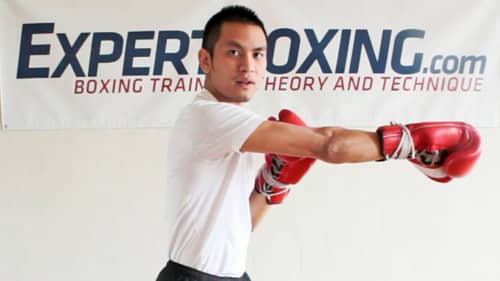
WHAT is the corkscrew punch?
HOW do you throw a corkscrew punch?
WHY should you corkscrew punch?
…and WHEN should you throw the corkscrew punch?
The corkscrew punch is no secret amongst trained boxers. If anything, it’s standard punching technique. But for everyone else from untrained fighters to even martial artists, it’s been built up to be some kind of magical secret weapon.
Here’s my explanation to demystify, once and for all, the “secret” behind the corkscrew punch technique.
What is a Corkscrew Punch?
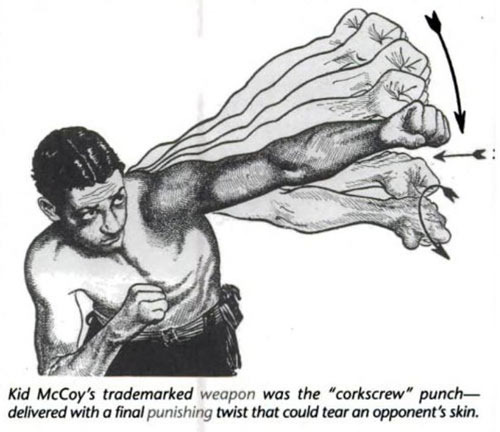
*** Image from BoxRec.com
A “corkscrew punch” is a punch delivered with a twisting of the wrist.
- The fist rotates inwards as the arm extends so that the palm is facing down when the fist lands.
This punch was said to be invented by a famous boxer named Charles “Kid” McCoy who (fought from 1891-1916) learned the punch by watching a cat strike at a ball of string.
McCoy imitated this corkscrew motion to add power to the punch and cut the opponent’s skin (boxers had very little hand protection back in the days). Being that he was wildly successful and known to be one of the great punchers in boxing, you can see why his punching technique became famous over time.
Over the years, many other fighters and practitioners of different martial arts have made similar discoveries resulting in many more variations of the “corkscrew punch”. What remains the same is that a corkscrew punch is a punch thrown with a wrist rotation.
CLAIMED BENEFITS of the corkscrew punch
I don’t agree with many of these but here are the popular reasons I’ve heard over the years regarding the corkscrew punch. I also listed my brief thoughts regarding their validity.
- increased power – POSSIBLE, but it depends on how you do it
- increased speed – POSSIBLE, but it depends on your fighting stance
- cuts the skin – NO, we have better hand protection now and cutting the skin has to do with angle and timing of the punch
- better wrist protection – YES, a punch thrown with a sideways wrist is less likely to get injured
- helps the punch get around a guard – YES, it can be easier to throw overhands with a horizontal fist than a vertical fist
- protects your chin – YES, a great benefit especially while trading punches
Why do boxers use a corkscrew punch?
1. Increased power & wrist protection – a sideways wrist is more stable allowing for more power transfer
2. Faster reaction time – to go from a defensive stance to a strike
3. Overhand punching angle – boxers throw many overhand punches unlike other fighting arts that focus more on straight punches
As I’ve already said before, the corkscrew punch is standard punching technique for boxers. They’ve been doing it since day one whether they knew it or not. You can always hear old school boxing trainer in the gym referencing the corkscrew punch technique by yelling:
- “Turn your punches over!”
- or “turn your hands over!”
Like I said, if you’re a boxer, you probably already learned how to throw a corkscrew punch. But if you’d like some more tidbits for extra punching power, keep reading! 🙂
How to Throw a Corkscrew Punch
Corkscrew punch technique for straight punches – (JAB or STRAIGHT RIGHT)
- Rotate the entire arm (shoulder, elbow, fist) as you extend your fist, so that the punch lands with the palm facing down.
Corkscrew punch technique for head hooks – (left hook or overhand right)
- Rotate your entire arm (shoulder, elbow, fist) as you swing the hook, so that your punch lands with the elbow at the same level of the fist (hooks) or higher than the fist (overhand).
Corkscrew punch technique for uppercuts – (left uppercut or right uppercut)
- Use the reverse motion of the corkscrew. Rotate your entire arm inwards as you dig the uppercut, so that your punch lands with the elbow down inside to support the uppercut.
- This type of corkscrew technique isn’t necessary for all uppercuts (especially for strategic reasons) but very powerful for tight uppercuts on the inside.
Principles of the corkscrew punch technique
1. The fist needs forearm support to deliver a powerful punch.
Every punch must be supported by the forearm! This is why the elbow always follows the line of the fist. Try throwing any punch without the elbow (and forearm) behind it and you will feel that it’s far less powerful and may even hurt your wrist. This is why your wrist hurts when you throw punches with a bent wrist (where the forearm is not directly behind the punch).
- When you throw a straight punch, the elbow must shoot forward (not out sideways).
- When you throw a left hook, the elbow must swing across at the same level (notdrop at a lazy angle).
- When you throw an uppercut, the elbow must be low in for the forearm to support the fist at an upwards angle.
The corkscrew isn’t so much of a technique anymore once you see that it’s natural movement. Wherever the fist goes, the elbow must follow it in order to support the punch. And the palm will face in whatever direction that feels more natural (downwards for straights or hooks, sideways or upwards for low hooks and uppercuts).
2. The corkscrew motion is to rotate the entire arm and lift the ELBOW quickly.
The point of the corkscrew punch technique
is to bring the elbow up quickly.
Try these motions from your boxing stance — with your elbows pointing down.
Hold your fist at a vertical angle (palm facing sideways) and punch straight out. You will see that your elbow points down and the forearm does not support your punch until your arm is fully extended.
Now hold your fist at a horizontal angle (palm facing down) and punch straight out, you will see that it’s more natural for the arm to rotate and the elbow points out sideways much sooner.
If you compare these 2 methods (horizontal fist vs vertical fist), you will notice that the horizontal fist causes the entire arm to corkscrew and that the elbow comes up quicker. And because the elbow comes up quicker, your punch will be stronger and have more power especially even if it’s not fully extended. This is the main difference between horizontal-fisted punches and vertical-fisted punches.
Some people like to argue about “boxing punches vs karate punches” or “horizontal-fist punches vs vertical-fist punches” and the answer is THEY ARE DIFFERENT PUNCHES. I don’t care so much about which one is better and why and how, etc. The most important thing is that I use the right punch to fit my strategy. And for most boxing-specific purposes, the corkscrew punch is more applicable (which is why it’s the standard). Boxers are by far the most powerful, most skilled, and most versatile punchers of any fighting art.
3. The corkscrew technique is a motion, not a position.
Why is it that boxers corkscrew their punches? Can’t we just position our fists and elbows already sideways to be in position to punch? The obvious answer is no because turning your fist palm down will likely force out your elbows sideways and make it hard to defend your body from your boxing stance.
REMEMBER: the basic boxing stance has your elbows down to cover your body. And if the elbows are down, this means it’s more natural to have your palms either facing sideways or even facing inwards towards your face.
And so the corkscrew punching technique is the motion that allows you to punch from your defensive position. The corkscrew punch will allow your elbow to go from being point downwards (for defense) to quickly lift upwards and rotate into your punch for maximum power.
NOTE: another benefit of the corkscrew punch is that it activates your shoulder and rotates to protect your chin as you punch. Try throwing a vertical-fist punch vs a corkscrew punch and you will see that your shoulder covers more of your chin with the corkscrew punch (well, it should). The exposed chin from vertical-fisted punches are another reason why vertical-fisted punches aren’t thrown in boxing.
4. Some punching angles can only be reached with a high elbow.
Aside from the increased power and chin protection, corkscrew punches are sometimes the only way to get around an opponent’s guard. Take for example, the typical overhand right. If you’re used to throwing only vertical-fisted punches with the elbow pointing down, you’ll see it’s impossible to bend your elbow to loop over your opponent’s defense. In these cases, using a corkscrew punching technique allows you to bend your elbow up sideways at an angle which then allows your fist to come around the guard and downwards at his face.
In boxing, we throw all kinds of punches – straight, over, under, and around. Whichever way the elbow needs to bend, we let it bend. And in many cases, letting the elbow bend out sideways gives us the necessary punching angles.
Secrets of the corkscrew punch technique
Corkscrew Punch Secret #1:
Corkscrew the entire arm! Shoulder, elbow, fist!
Don’t think about the fist! Think about the entire arm, especially the elbow and the shoulder. Try to feel the snap and quick rotation in your elbow and shoulder. This will require a relaxed arm which then SNAPS into place with the corkscrew motion.
When you do it right, you will feel your elbow flick up quickly as the entire arm supports the punch. I recommend practicing your corkscrew punches with straight punches first. A big tip: you need a very relaxed arm to corkscrew right.
If you’re a PUSH-PUNCHER or someone who likes to drive through every punch, the corkscrew motion will slow you down and make you feel like you’re using a lot of energy. Instead you should feel like the corkscrew is a fast, easy way to snap your elbow from defense position to punching position.
Corkscrew Punch Secret #2:
Snap your lats and shoulders to rotate the fist.
Again, don’t focus on your fist. Try to initiate the corkscrew effect from the most powerful muscles farther back in the arm—mainly the shoulders and lat muscles. All you have to do is rotate the forearm and elbow and the fist will turn with it.
Relax your entire arm and then just snap with your lat and shoulder muscles. Once you get the snap right, all it takes is a little squeeze from the fist and forearm and you will feel a VERY POWERFUL SNAPPING CORKSCREW PUNCH!





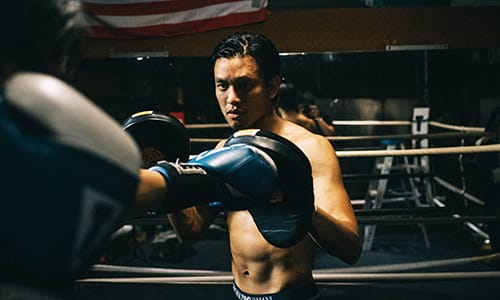

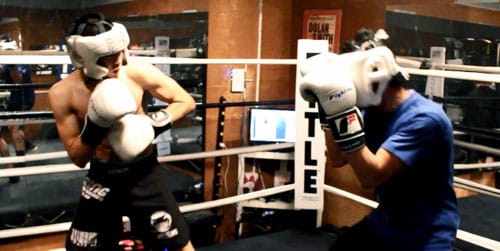

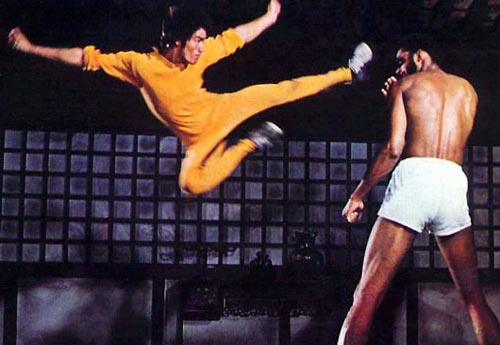

Excellent article…I
My favorite punch is the Right Hand
Another absolutely brilliant article Johnny, thank you very much 🙂
I’ve got a question: You say that if the elbow goes up quickly than the punch is faster. Are there any more techniques how to move your elbow quickly or just Corkscrew punches ??
If you know any, please tell us about them. 🙂
If the elbow goes up faster, than the punch will have its power much sooner. Another way to have the elbow come up fast is to have it already there in the first place…but of course, this isn’t the most optimum position for defensive reasons.
Hello Johnny is there techniques to throwing a punch that would minimize injury to snap the punch without worrying about hyperextending the arm. Like a form or something I can’t tell you how annoying it is to feel a little pinch underneath the armpit. Elbow and wrist at times.. I want to be 50 years old and up and still be able to throw punches. I don’t want a long-term injury waiting to happen so is there a technique to throwing it with that avoid injury altogether.
See if you can incorporate this. Straighten your arm during punches by stretching your bicep, rather than straining your tricep. See if that visualization helps you. The technique exists. Just maybe a bit hard to explain.
whaaaaaaaaaaaaaaaaat the fuck i tried this and its so true
Johnny, can you please this point further on the message board (and make a video or article that explains in the future) ?? I had pain problems today, and technique intrigues me, if you can explain more ! very important for injury prevention
Thanks,
thanks for the awesome article johnny! u got me wondering,do martial arts and mma teach fighters to throw jabs and crosses with vertical fists? also,i was shadowboxing the other day and this taekwondo guy that doesn’t box said i don’t know how to throw a proper punch because my ‘wrists weren’t rotating 180 degrees’ that didn’t make any since because my friend that’s gonna go pro in boxing soon, had trained me enough to where my jabs and crosses point at the ground ,it does feel like in shadowboxing maybe my hands don’t ALWAYS flip over to the ground,but from what i’ve read the hand angle doesn’t seem to matter alot, and watching shadowboxing on the web and tv it seems like thats normal,so i’ve started out with just trying to put snap and power in my punches for now..so i guess i’m wondering if i’m wrong by training like that .thanks Johnny, i love this site! i don’t know how you do it man
The general idea is to throw straight punches so that the palm is facing the ground at the full extension of your punch. If you’re doing something different, you should have a technical or strategic reason for it.
Eijie Date is the one who use this punch on the anime hajime no ippo …
nice article i want to know this and improve my right hand. thanks sir johnny
I tried to think of my elbow rotating instead of my wrist and my shoulder now smacks me in the jaw lol
GOOD! THIS IS GOOD!
Seriously?you mean this serious or not
This is interesting… I like to use vertical fist punches to split the guard of my opponent with jabs especially and crosses less often. I’ll use the vertical fist with hooks mostly because it sneaks through more easily and tends to land more often. I like your explanation of how the elbow drives the fist and generates more power.
When I studied Wing Chun kung fu we were taught that the vertical fist is is the more anatomically “correct” way to punch because the radius and ulna are in a parallel position rather than twisting over each other as in the corkscrew punch. I wonder how much of a difference this makes when one fights bareknuckle versus with handwraps and gloves…I tend to think that with the handwraps and gloves that one can get away with more twisting, turning and weird angles because the wrists are protected fairly well. I also think this is why there are more ancient martial arts with palm striking techniques instead of closed fists, not because the palms give some kind of great power but because there is less chance of injury. But all this is pure speculation.
Back to boxing, I think that one other reason to corkscrew the punch is because it raises the shoulder more, thus creating better protection for the chin. And the raised elbow is better defensively versus punches coming across the arm because of it’s outward facing position. Of course, like you said, there is no “better” way to punch, only tactical movements…
Keitharino…
I would disagree with the verticle fist actually being more anatomically “correct” only for the reason that, if you take most solid matter (in this case, bone & muscle etc.) and twist it, it becomes more compact, thereby, creating a more dense support for the object that will absorb the initial impact.
As a switch hitting southpaw i was doing this naturally with my lead left hook, but I’ve been killing myself trying to figure out why my right lead hook only felt good as a vertical fist. Soon as I read this I popped my shoulder into it and boom, perfection. all i was missing was a nice, sharp, close range right lead hook, and you’ve just completed the beast. Thanks bro and much respect.
Good job figuring it out! The southpaw right hook is a killer weapon!
Good article Johnny. Can you do an article on shadow boxing? It seems long overdue! I messed up my shoulders! I can hardly shadowbox for any length of time. I think I have minor injuries in my shoulders (muscle & joint) and it isn’t very noticable until after some shadow boxing. I thought I was doing it correctly, but apparently not. And my shoulders are not feeling any better. This is rather upsetting. I’m in an athletic slump right now. As soon as I’m in a postition to do boxing or jiu-jitsu, injuries pop up, and I don’t want to make it worse. I’m 18 Johnny! I’m too young!
Watch my video on shadowboxing. The article will come soon enough.
this is my first post. I would like to say i am a fan of you man. Thank you
sir, does my fist needs to be in a 90 degree angle or a 45 degree is enough for a cork screw? Thanks for the info about the historic data on the said punch, i never knew kid mccoy was behind this. the first time i heard about the corkscrew punch was in the anime hajime no ippo. Its nice to hear that this is actually has historical evidence. another punch ive seen in the anime its called the “gazelle punch” i wonder if its done in boxing, but its kinda similar to ryu’s uppercut in street fighter. if it is can you make a guide on it.. as well as other techniques like “criss-cross”(counter to a counter punch) and a “wolf fang”(i dont know if i get this right i forgot) its like a wolf bite, its starts with an uppercut then quickly followed by an overhand right… theres also the “demsey roll” i know jack demsey invented it, can you shed light on the techniques and hoping for a great guide from you soon for all these punches.. thanks don
Land the punch with your palm facing the ground. If you’re rotating less, than I guess it’s still a corkscrew but maybe not a “full corkscrew” and won’t get the full benefits.
@don
I love the anime too! I know Dempsey Roll and Gazelle Punch were taken from actual signature moves from real boxers. However the real punch is from Floyd Patterson and looks nothing like the one in the anime, plus it is very unlikely to land against a skilled boxer. Recent attempts to imitate it have been very few and I have never seen one by modern boxers land. But other moves like criss-cross, wolf fang, etc. are just normal maneuvers in boxing. Of course the anime version of wolf fang is unrealistic because no one can actually claim to connect the overhand right “every time” the left uppercut lands. So the speed was a fictional part made up by the anime. The overhand right relies more on angle, and the knockdown is from your body weight traveling vertically down with gravity onto your opponent’s jaw.
@Johnny
I know it’s from an anime but I’m actually interested to know your opinion on their “jolt” since you wrote a lot about how power is generated in boxing.
http://ippo.wikia.com/wiki/Jolt_Counter
This here says that you sprint after slipping a right cross and counter with a right cross. In real life, do you believe it will generate a lot more power than the “grounded” stance you speak of? Before that, is it even possible to sprint after a slip and be balanced enough to land a solid cross?
Yes, you can burst after a slip. The “jolt counter” is nothing more than a made-up name of a counter punch. There are many punches in boxing, each of them effective depending on the situation. Some more universally effective than others.
As for how much power this “jolt counter” can generate…it depends on the details. How does it work? It’s not enough for you to tell me that it’s a fast counter after a slip. There are so many punches like this and just because you give it a name doesn’t mean I know specifically what angle and details are behind this one made up name. I wonder if the person who coined has ever even thrown a “jolt counter” in the ring. Until somebody clearly defines and shows this to me, I have no opinion other than to say it’s possible.
mr. Johnny
here are the techniques im talking about, can you analyze all of it and make guides for all these great techniques. thanks in advance
http://ippo.wikia.com/wiki/Category:Techniques
I’ll do what I can. I only know about actual boxing techniques not fantasy ones made up by anime, even if they’re inspired by actual fighting techniques.
Great punch, man you need to talk more about these alternative punch, so I like JAB and FLICKER DEMPSEY ROLL
Man you already thought of talking about dirty boxing, i think a good topic, I know that the focus of the site is about professional boxing but I think a good topic on Tecnic forgotten
What’s the difference between your description of a corkscrew punch and a normal punch? Your knuckles should point down on a punch anyway. In England, the ‘screw-shot’ is where you rotate your fist the other way so your knuckles point upwards.
It’s already explained in the article that corkscrew technique is pretty much standard punching technique. I made this article for the people who keep asking me to explain the “corkscrew punch” as if it’s a different punching technique.
My friend taught this to me as just basic technique, but when I saw the title of this entry I thought you were going to talk about the Eiji Date move in the Hajime no Ippo anime series as if the move actually existed.
Should my palm end up facing the floor in a left hook too? I’ve got the elbow but I haven’t been twisting my wrist and no-one’s corrected me so far 🙂 Luckily I haven’t been doing it for years so I still have time to fix it before muscle memory is too well set! Thanks
Ah, just read your excellent article on Mastering the Left Hook – which has answered my question. Thanks for all the great articles and by the way my trainer recommends them as reading for all of his charges 🙂
man fabulous. i never realised that we take this for granted so much. the twist of the elbow twists the wrist. it brings my shoulder into my jaw except on a long hook. for me john if i get to hit with full extension i go beyound the palm straight down at the floor and my right fist (on a straight 2) ends up near vertical with my palm facing away from my face: more rotation. it creates more stability because i can close my fist as hard as i want without worrying about taking the impact. to me, you have to turn it over THROUGH the punch and not just up to it. what do you suppose that does ?
Corkscrewing the punch up to the point of impact VS past the point of impact. It’s a good question.
I think of it the motion in two parts: the movement in my hand and the power that it generates. The hand (or arm) moves with a certain technique. And the power generated has a certain character. Beginners need to learn the punching technique but then once you’ve mastered it, you have to stop thinking about the technique so much. Because then it becomes empty and without purpose. You have to look beyond the technique and think about the character of the generated power.
Basically, I’m not trying to think about my corkscrew. I’m only trying to think that my ENERGY or my GENERATED POWER is what corkscrews through my opponent. So I imagine my power corkscrewing and plowing right through my opponent’s skull but my actual hand itself does not. I actually just let my body move naturally in the moment and then control only the generated energy that comes out. The corkscrew is actually a natural movement in itself because your forearm will want to turn as you try to drive a straight punch forward with power. The risk of trying to control that corkscrew by hindering its movement, is that you end up making it unnatural and awkward and decrease it’s power and effectiveness. And then by focusing too much on the movement, you also lose your focus on the energy and so the energy lose its effectiveness as well.
Can I throw this to the body with straight punches
Yes, you can.
Johnny ,
How can i cut my opponents skin in boxing ??
Keep aiming around their eyes and hopefully you’ll get a punch that splits it open. Opening a cut anywhere else isn’t as useful (because the blood won’t flow into the eyes or mouth) or likely because the rest of the body doesn’t any sharp bone protrusions that could create a cut.
I have a friend. He doesn’t know how to fight , but always looks for a fight with me …….
How can i teach him a lesson without hurting him real bad ….. ???????????
Bring a bigger friend for him to fight. 😉
He will shit in his pants ……….
Hello Johnny, I just wanted to ask if its good technique to turn your punch over past ninety degrees, almost so your thumb points towards the ground when corkscrewing your punch. I ve noticed it brings your shoulder up more to better protect your chin, but can it be dangerous for your wrist? I also noticed that when you over rotate the shot a little, your front knuckles land better and have a little more reach and follow through. What do you think?
I primarily use a flicker jab. i know it’s not meant to be a powerful jab but do you think i could implement the corkscrew to increase the power even a little bit? Thank you for these articles by the way it is incredibly helpful
Alright so, I’m just now starting in boxing & as u said I have naturally punched with the corkscrew technique. But I have a completely different question. I am right handed but instead of fighting in the orthodox stance, I naturally fight southpaw. I’m 5’8 & I weigh 134 lbs. Despite being on the skinnier side, I have a very punch. But my problem is that my left hand is completely uncoordinated compared to my right hand. Can u tell me any tips to help strengthen my left hand? Also is it wrong for me to naturally fight this way? If u could answer these questions, it would be much appreciated 😀
**Very hard punch**
A better explanation is that your thumb will be facing the ground like you’re giving a thumbs down
Interesting. I’ve always naturally punched this way because it’s what I was taught in Tae Kwon Do as a kid. I guess punching straight would be quicker, but you’d have more chance of hitting with the last two knuckes or getting a bent wrist.
Basic question that I don’t know the answer to: Right cross technique is lower body turn, but as far as the upper body do you throw primarily with the right shoulder or combination of shoulder, arm, etc…?